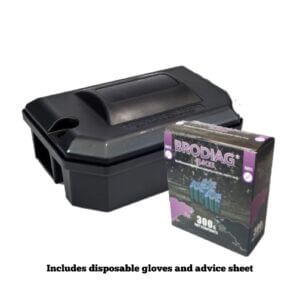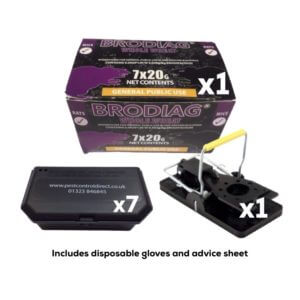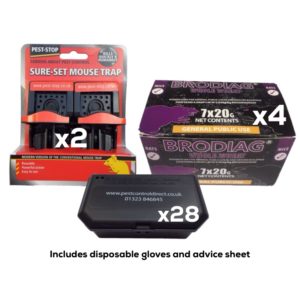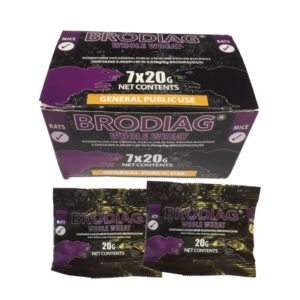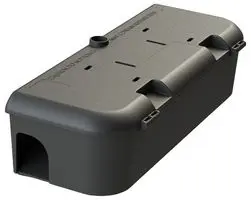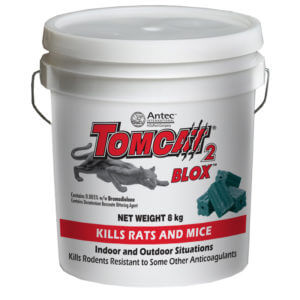Rodent Control
-
-
-
Ratpak 1 with Single Feed Poison
£15.60 Including VATNo resistance to this poison 99% efficacy rat killer
-
Ratpak 2 with Single Feed Poison
£33.60 Including VATNo resistance to this poison 99% efficacy rodent killer bait
-
MousePak 1 to control a minor mouse problem
£13.98 Including VAT99% Efficacy Single Feed Poison included
-
Mousepak 2 to control a moderate mouse infestation
£25.20 Including VAT99% Efficacy Single Feed Poison included
-
MousePak 3 to control a heavy mouse infestation
£37.20 Including VAT99% Efficacy Single Feed Poison included
-
Brodiag Single Feed Rat/Mouse Poison (7 x 20g Sachets)
£5.04 Including VAT99% Efficacy – Wholewheat Sachets
-
-
-
-
-
-
-
-
-
-
-
-
-
Rodex Wholewheat Rat Poison 1.5kg (10 x 150gm Throwbags)
£24.60 Including VATMaximum legal strength
-
-
-
-
-
-
-
Jade Cluster Grain Bars Rat/Mouse Bromadiolone Poison 5kg
£78.00 Including VATProfessional Use only
Rats & Mice
Rodent control is something that most people can manage to do themselves. In most cases, rat poison and mouse poison sold to the public is the same strength as the pest control professionals use (until early 2018). Below you will find a range of pest control rodenticides for rat control and mouse control.
There are rat traps, mouse traps, mole traps and other pest control products to effect good vermin control. Rats and Mice are going to present some serious pest control problems in the future due to new waste disposal measure that see waste food either being composted or left uncollected for longer than ever before.
Another trend that is appearing is sub decking infestations of both rats and mice, these pests finding cover under popular decking structures. In creating ourselves a pleasant deck we provide the perfect safe environment for vermin, rats, mice and insects ! At least you can fairly safely use rat poison and mouse poison under decking.
A GUIDE TO ACTIVE INGREDIENTS WE STOCK:
BRODIFACOUM:
Brodifacoum, a second generation anticoagulant, has perhaps the highest rodent toxicity of all the anticoagulant rodenticides. When introduced it was found to be effective against susceptible and first generation anticoagulant resistant rodent. Because of its higher toxicity and other characteristics, brodifacoum is able to deliver and acute LD50 dose through its consumption in bait of less than 10% of the average daily food intake of both rats and house mice. This high toxicity does not reduce the average time of death of the rodents nor does it reduce the average time taken to control an infestation. It does decrease the amount of bait that has to be consumed to ingest a lethal dose and potentially the number of days over which bait consumption takes place.
BROMADIOLONE:
Bromadiolone is a second generation anticoagulant. When introduced it was effective against first generation anticoagulant resistant populations of both rats and mice, although there was some suggestion that treatments against resistant house mice populations might need to be extended. Even with its higher rodent toxicity than many other anticoagulants, it is not considered sufficiently toxic to be used under a pulsed baiting regime and saturation baiting is recommended for this anticoagulant. It can be used both indoors and outdoors and is available for amateur use.
DIFENACOUM:
Difenacoum was the first of the second generation of anticoagulants. It was discovered as a result of the search for alternative anticoagulants to overcome warfarin resistant rat and mouse infestations. Field trials in the early 1970s indicated that difenacoum was effective at eliminating warfarin resistant common rat populations and it also gave high levels of control against warfarin resistant populations of house mice. Some problems with palatability have been reported which seem to have been overcome in more recent years. Difenacoum should be applied using the saturation baiting technique. It can be used indoors and outdoors and is available for amateur use.




